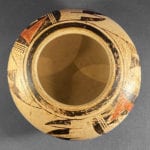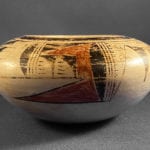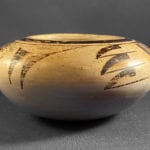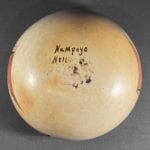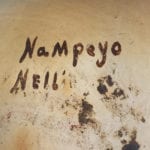This seedjar was once almost trash. Now it is both a significant part of this collection and helps explain the uncertain history of another pot I bought 9 years ago (2010-20). Together the two pots give us some insight into Nampeyo family history.
The pot is signed “Nampeyo/Nelli” with the “e” of the second word worn off or obliterated by a black smudge. Thus I believe that the pot was formed by Nampeyo after 1917–1920 when she was functionally blind and painted and signed by her middle daughter Nellie. (See “Appendix E” for a discussion of pots signed “Nampeyo” during the first four decades of the twentieth century.)
Form:
As is usual, the bottom of the pot, which was formed on a puki form, is somewhat thicker than the sides. The sides and top are even and substantial, but not thick. Where the upper surface joins the lower at the waist, there is no discernible juncture on the inside of the pot. Nampeyo remained a master coiler of clay, even when substantially blind.
Design:
When listed on Ebay, the upper surface of 2019-08 was irregularly covered with a dark brown film. The pot in that condition is shown here:
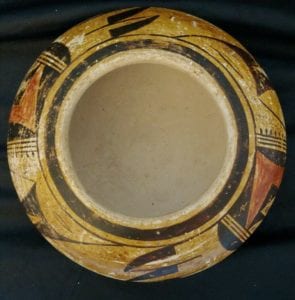
This film, probably old shellac, was easily removed with industrial strength acetone. Once cleaned, it became more apparent that the design was actually two avian images, with the birds in an inverted position.
The wide mouth of the jar is encircled by thick-over-thin framing lines typical of Sikyatki Revival pottery. There are no lower framing lines, which, were they present, would not have been seen with the pot sitting upright.When sitting on a table, the design looks like a jumble of typical Hopi pottery elements. Only when the jar is held so the viewer is looking directly into the mouth do these elements resolve themselves into an image of a bird repeated twice. Except for one variation in painting, the two birds are identical. One image is more worn than the other, which may explain why someone shellacked the jar to protect it.
The design will be described with the birds in a head-up position, i.e. with the seedpot inverted.
The heads of the birds are in the shape of a slightly off-center hill skewed to the left. The lower edge of the hill (the chin) is formed by the thin framing line as if these tired birds had laid their heads down to rest. The right slope of the head does not quite reach the framing line before it angles sharply upward to form the hypotenuse of a triangle that rises sharply then falls directly to the thin framing line that is its base. This triangle forms a neck. The eyes of the birds are a thin, long narrow shape that echos the shape of the head. The heads and necks are stippled with small dors of the black paint, though the narrow eyes remains unpainted. Two solid black triangles form a crest on each bird’s head.
To the rear of the triangular neck are two sets of four vertical lines forming a three-lane highways set 2-inches apart. Between them is the central panel of design. Intruding into the stippled neck from the first set of these lines are a series of from 10 to 15 parallel hairs, the number varies between birds.
In the central panel of design a wide, black hill shape is based on the first set of parallel lines and bows toward the rear. From this highest half of this black hill juts a rear-pointing red triangle, like a fin or wing. Below it, on one bird, a black line parallel to the bowl’s lip extends 4.5 inches back from the black-hill element to form the upper edge of the body. On the second bird there is a gap between the black-hill element and this black line, allowing the red from the triangular wing to pour through the gap.
Inside the body of the birds this red paint forms a shape that looks somewhat like an old-fashion plough: a rectangular form sits on top a triangular blade. In one rendition the rectangular superstructure is slightly trapezoidal.
Below the plough blade a residual black triangle fills the void. Above the red blade are two unpainted downward-pointing fin shapes enclosing four parallel lines. The residual around these fins forms two triangles, their hypotenuses curved by the fins.
As was true of the first set of parallel lines, the right most line of the second set also serves as the base for a wide, black hill shape that arches towards three tail feathers. The design to the rear of this hill is outlined by a thin black line but is otherwise unpainted, except that the lower half of the feathers’ points are painted black.
In 1911 Dr. Barrett from the Milwaukee Public Museum visited Hopi with the express purpose of documenting the stages of forming, painting and firing pottery by Nampeyo. In a article summarizing this collection, Stephen Schwartz publishes a photograph of five pots collected by Barrett, one of them carrying a creature similar to the one on pot 2010-20 (1969:116).
That Nellie chose to paint the birds upside down when the bowl is upright is interesting for a couple of reasons. First, Ed Wade has said that an inverted bird design, as seen on the prehistoric Awatovi murals, indicates that the bird has been sacrificed and is thus a spirit being. I know of one such jar in a private collection.
Second, the only other Hopi jar with an inverted animal image that I have seen is pot 2010-20 in this collection, a pot that carries a Harvey label “Made by Nampeyo,” but which I argued was painted by a much less experienced painter, probably a young Nellie. Jars 2010-20 and jar 2019-08 have similar inverted layouts and the animals on both jars have similar heads (but not bodies). That jar 2019-08 was clearly made by Nellie gives weight to my argument concerning the maker of pot 2010-20. Apparently Nellie inverted both sets of animal images intentionally, but we do not know why. The design on 2019-08 is more elaborate and more skillfully-painted than on 2010-20, thus I assume that pot 2010-20 was made by a younger Nellie and pot 2019-08 was painted when she was more experienced.
Nellie is always described as a fine and kind person, but is often dismissed as an indifferent potter who did not make many pots (Blairs, 1999:203). This pair of pots with similar images and odd orientation indicate both that Nellie had a particular sense of style and that Nampeyo and her middle daughter had a longer and more linked career as potters than the literature suggests. (See Appendix E.)


